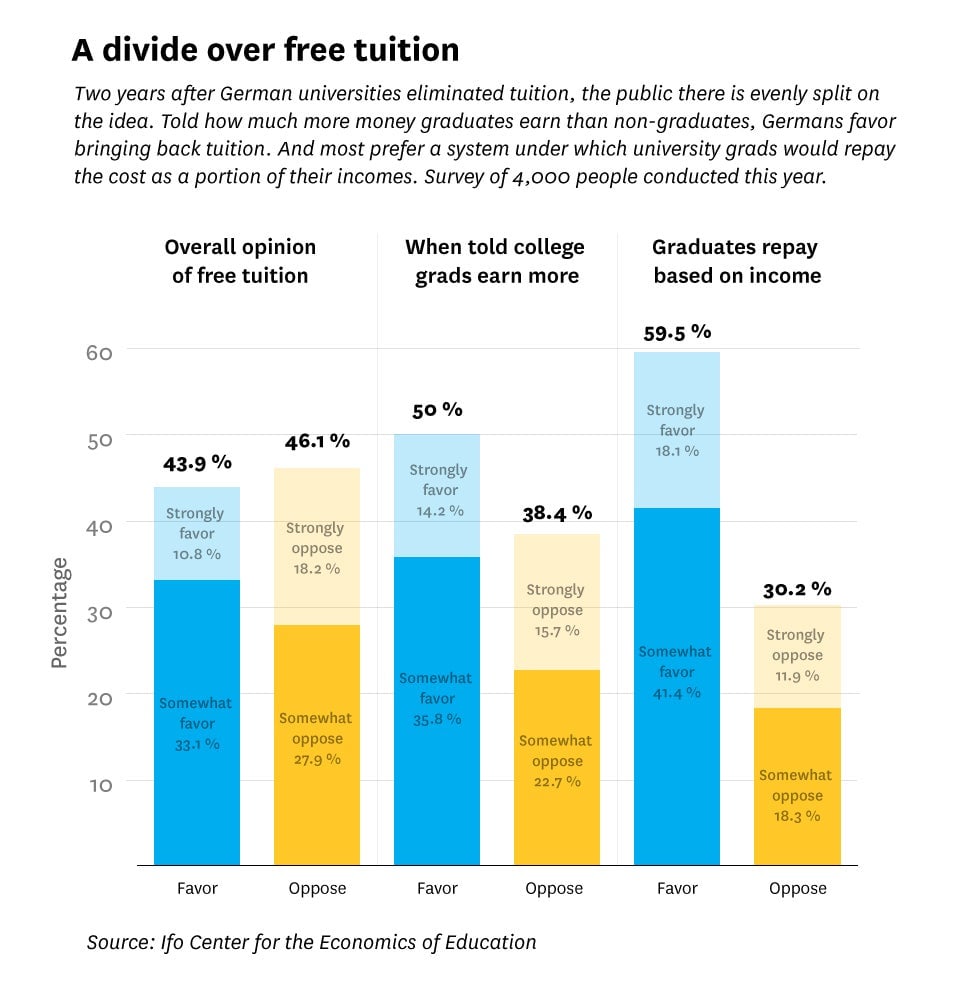Germany proves tuition-free college is not a silver bullet for America’s education woes
Claudia Niessler wouldn’t have attended a university that charged tuition, though even without it her living expenses in college require her to work as many as 20 hours a week at a supermarket.


Claudia Niessler wouldn’t have attended a university that charged tuition, though even without it her living expenses in college require her to work as many as 20 hours a week at a supermarket.
Stefan Steinbock pipes in that having to pay tuition would discourage people with good grades but low incomes from getting university degrees. Eliminating financial stress means he can focus on his academics.
But Peter-André Alt contends that being unable to charge tuition means universities are overcrowded and thinly stretched. Meanwhile, hard-pressed taxpayers are unfairly forced to fill the void, even if they don’t go to college or have kids who do.
Niessler and Steinbock are students at Freie Universität in Berlin; Alt is the university’s president. Together, they embody the surprising ambivalence, unexpected nuances, and general pros and cons of tuition-free university in Germany, a model proposed in the US by Democratic presidential candidate Hillary Clinton.
The university’s name refers not to its cost, but to its origins at the outset of the Cold War, when it was established to be free of ideological influence in then-divided Berlin. “The fact of the matter is, of course, that any university, if it is a university, is free,” then-US president John F. Kennedy pronounced on the same day in 1963 that he made his famous “Ich bin ein Berliner” speech. “So one might think that the words ‘Free University’ are redundant. But not in West Berlin.”

Like other universities in Germany, Freie Universität was free of charge in 1963. In 2006, German universities were allowed to begin imposing tuition. Student protests and a political backlash followed, however, and by 2014 tuition was once again being eliminated at the public universities that educate the vast majority of German students. Except for small administrative fees—at Freie Universität, €304 per semester, or about $341, most of it for a public transit pass—most German undergraduates now pay no tuition.
This makes Germany an ideal test case for the proposal, first raised by Sanders, that has now become a centerpiece of Clinton’s presidential bid. (Republican presidential nominee Donald Trump’s education plan calls for student loan repayments to be capped at 12.5% of the borrower’s income, with any remaining debt forgiven after 15 years.)
The verdict? It’s mixed. German university enrollment rose by 22% as tuition disappeared, the Ministry of Education and Research reports—much faster than in other member countries of the Organization of Economic Cooperation and Development, or OECD—while the number of Germans who opt instead for vocational education has declined. On the other hand, the cost to taxpayers of subsidizing higher education went up 37%.
The amount earmarked to help students with their living expenses has remained unchanged for years, however, and, even without having to pay tuition, students like supermarket worker Niessler increasingly have to resort to jobs or loans to cover rent and food, especially if they’re from lower-income families that can’t help.
Unable to charge for tuition, meanwhile, universities contend that they are blocked from an important source of revenue. And economists wonder how long the government will be able to support these costs, especially with a new law looming that will limit the amount of money Germany’s 16 federal states—which operate the universities—can borrow.
Two years after the last few German universities went tuition-free, Germans are almost equally split about the idea. According to a survey conducted earlier this year by the Ifo Center for the Economics of Education at Ludwig Maximilian University in Munich, 44% of Germans are in favor of re-imposing tuition, while 46% want to keep things as they are.
Interestingly, when informed that university graduates earn 40% more than those with a vocational education, the proportion of respondents who support bringing back tuition rises to 50%. And an even higher 60% like the idea of requiring students to pay for their tuition after graduating as a portion of their incomes, a model similar to systems in England and Australia.

In the US, the idea of free tuition remains a popular one. In separate polls by Public Agenda and the Campaign for Free College Tuition, about two-thirds of Americans said they support making tuition free for lower- and middle-income students; a more recent survey by the foundation New America puts the figure as high as 70%, but also found that an equal proportion of people think the idea is unaffordable.
Analysts, however, worry that the issues cropping up in Germany could similarly plague the Clinton plan. So far, Clinton hopes to leverage state and federal money to make the in-state public universities and colleges that account for more than two-thirds of US enrollment tuition-free by 2021 for students from families making less than $125,000.
Clinton’s proposal would increase enrollment at in-state institutions by from 9% to 22%, Georgetown University’s Center for Education and the Workforce predicts. It would also cost an estimated $350 billion over 10 years, according to the Clinton campaign, which says the money would come from eliminating certain tax deductions for the wealthiest Americans.
Critics like Sara Goldrick-Rab, a professor of education policy at Temple University and the author of a new book, Paying the Price: College Costs, Financial Aid, and the Betrayal of the American Dream, argue that neither Clinton’s nor Trump’s plans actually address the burden rising fastest for American students: outside costs, including room and board, books, supplies, and transportation.
In Germany, low-income students can apply for grants and loans totaling around €650 a month ($580) to pay for living expenses. Since almost all students live off campus, this creates an unanticipated outcome: Even in a country where universities don’t charge tuition, students are still graduating with debt.
“We don’t want students to go into debt because they want to study,” said Mandy Gratz, a member of the executive committee of the Freier Zusammenschluss von StudentInnenschaften, or FZS, the German students’ union. Accumulating costs of living means 68% of German students work, Gratz said over coffee in a café in Berlin’s Mitte district. and “students from a lower socioeconomic background try to study faster.” Students are also more likely to choose practical subjects like marketing or human resources. Meanwhile medicine and law degrees, which take longer and therefore cost more, remain careers mostly for the wealthy.
Gratz herself is the first in her family to go to college. She started out majoring in comparative literature and political science, but became concerned those subjects might not lead to salaries high enough to pay off her loans and switched to a teaching degree. She also works one full- and one part-time job.
In Germany, making tuition free hasn’t led to any noticeable change in the demographics of who goes to college, said Ludger Woessmann, a professor of economics at the University of Munich and director if the Ifo Center for the Economics of Education. As in other countries, enrollment depends more on whether or not a student’s parents have higher education experience than what the cost is.
Three-quarters of German’s adult college graduates have children who also earn university degrees, Woessmann said, compared to a 25% of adults who don’t have degrees. (In all, 57% of the equivalent of high school graduates go on to college here, the OECD reports, compared to what the Bureau of Labor Statistics says is 69% of their American counterparts.)
The Georgetown analysis projects that, under Clinton’s plan, a surge in applications to top public universities would make those schools much more selective, shutting out poor and non-white students. Those socioeconomically disadvantaged applicants would in turn land at already overburdened open-access regional public universities and community colleges with low success rates.

The quality of the education is a concern in Germany as well. The shift to dependence on government funding, combined with the increase in enrollment, has also meant a 10% decline in spending per student in the last few years, the OECD reports. Today, German public schools spend about $16,895 per student, compared with $27,924 per student in the United States. Starved for funding, German universities are seldom near the top of international rankings.
German undergraduates, Gratz said, are stuck in lecture halls “with hundreds and hundreds of students.” PhD candidates, she said, do much of the instructing. The universities “say they do not have enough money for research. But they do not have enough money for teaching, either.”
Alt, the president of Freie Universität, agrees on this point.
“One disadvantage is that we lose one opportunity to enhance our financial support and budget situations,” said Alt, who spends much of his time vying for independent sources of funding such as international grants and corporate gifts. If the university could collect fees, he said, “We could invest much more and we could do much more.”
Also, Alt said, when most of the costs fall to the government, “The taxpayer is paying for the universities whether or not they’re benefitting. A fee system assigns the cost to the person who is benefitting.” This, in a country with the third-highest tax rate in the OECD—almost 50% of income.
Woessmann, the University of Munich economist, agreed that “as a general rule, universities in Germany do have much fewer resources than at least the higher-level universities in the US. University presidents in general will always tell you they don’t have enough money, but in general I think they have a point there. If the universities were able to [impose] tuition fees, that would surely in general affect the quality.”
Those arguments have so far largely been eclipsed, however, by the power of the college-aged voting bloc. Unlike in the United States, where barely one in five college-aged Americans go to the polls, college students in Germany vote in huge numbers. “In the end, it was a political issue,” Alt said with a sigh. Candidates “could lose a campaign for charging fees.”
Ultimately, it may be economists, and not politicians, who determine the fate of Germany’s tuition-free schools. A provision called Schuldenbremse, or “debt brake,” will limit how much German states can borrow beginning in 2020, restricting funds available for college costs.
“We will come into a situation where, just like in any downturn, there will be real problems for states to keep up the funding for the universities, or raise it,” Woessmann said. “And I think by that time we’ll have another discussion about free university tuition.”